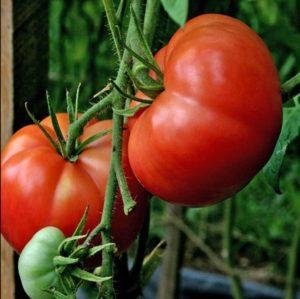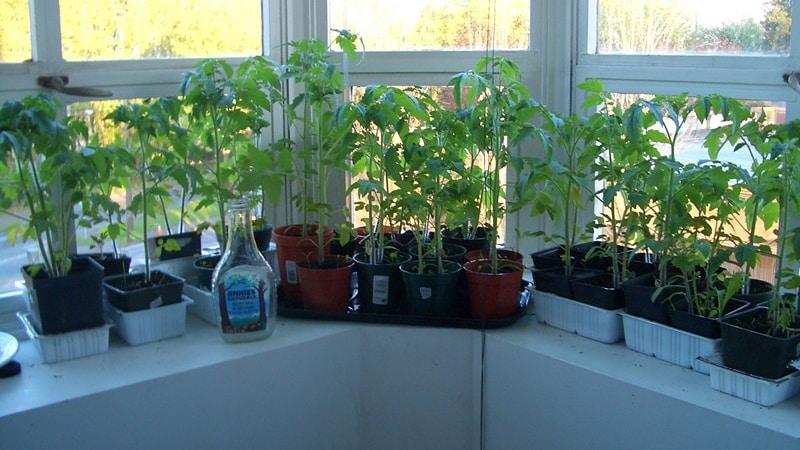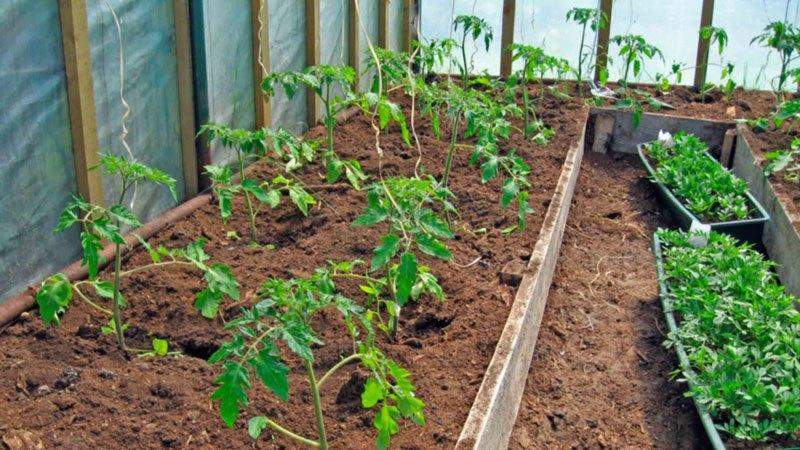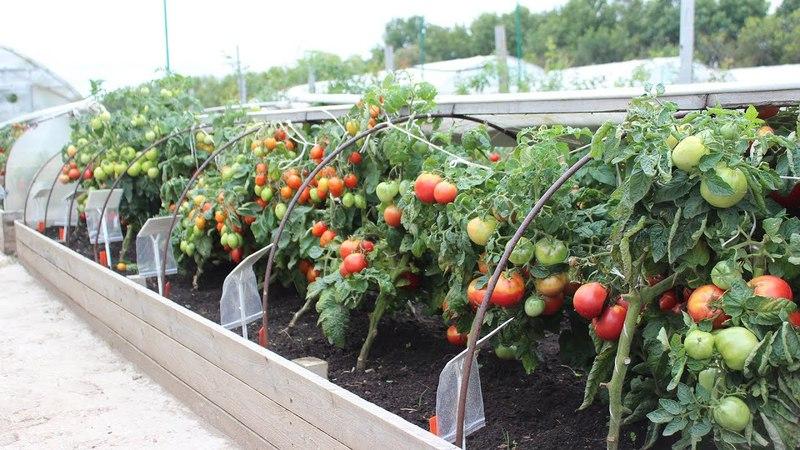Tomatoes "Bugai" red - a large hybrid that gives a rich harvest
The red Bugai tomato was given its name because of its appropriate size and appearance. It differs from other varieties in two features - high yield and huge fruits. Give him a place in the garden, and success will be guaranteed. Breeders consider Bugai one of the most successful crossed tomatoes, and consumers speak only positively about it.
Read on to learn how to grow large and tasty tomatoes in your garden.
Characteristics and description of the tomato variety, yield indicators
Red Bugai has recently appeared on the modern market. This big guy was bred by Siberian breeders.
The bush is tall, indeterminate type. Reaches 2 m in height. It has strong stems, therefore, the plant can withstand the loads of heavy fruits.
Fleshy, bright red tomatoes have a round but slightly flattened shape. The pulp is elastic, juicy and sugary. The taste harmoniously combines sweetness with sourness. Tomatoes contain few seeds - this is a small minus for those who collect seed material themselves.
The main feature of the Bugai variety is the large size of the fruits.. When grown correctly, each tomato reaches an average weight of 600 g, but can grow up to 1 kg. One bush produces up to 10 kg of harvest, and one bunch can accommodate tomatoes with a total weight of up to 2 kg. The first fruits ripen 110 days after germination.
On a note. To get large fruits, experts advise growing the crop in a greenhouse, since tomatoes are smaller in open ground.
The tomato has gained popularity due to its high yield.
Brief description of subvarieties
A variety of large tomato, Bugai pink F1, is not much different from red. The tomato belongs to the indeterminate type. Its height is from 1.7 to 1.9 m. The plant has a strong stem. The tomato has many thin, light green leaves, similar to potato leaves. Culture forms stepchildren. The average fruit ripening time is 115-120 days.
Each inflorescence bears 3-5 tomatoes. The fruits have an evenly colored rich pink color, without spots. The tomato is flat-round in shape with slight ribbing. The pulp is pink, sugary. The taste is excellent.
For your information. The variety is grown both in open ground and in greenhouse conditions. However, it grows better and bears fruit longer in a greenhouse.
Pros and cons of the variety
The fruits of the Bugai red tomato reach impressive sizes and do not burst. Not every variety can boast of this feature.
Other advantages of the type:
- the planted seeds germinate synchronously and, almost simultaneously, the fruits are formed and ripen during the growing period;
- the variety is resistant to pests and diseases;
- tomato fruits grow very large (on average 500-600 g);
- Bugai red tomatoes bear fruit for a long time and give a bountiful harvest;
- excellent taste;
- The variety is unpretentious in care; the plant requires a minimum of attention during the growing season.
The vitamin variety is distinguished by a high concentration of minerals beneficial to the body.It contains B-vitamins necessary for the normal functioning of the gastrointestinal tract, as well as vitamins A, E and C, each of which makes a significant contribution to the functions of all organs and tissues.
What kind of defects does the variety have? Although the crop requires minimal care, it is worth taking time to plant and form the bush. Also, Bugai tomatoes (like many other varieties) need support and tying. This provides an aesthetically attractive and neat appearance of the garden bed, as well as ease of use. watering and harvesting.
In order for fruits to reach a large size during growth, they require enhanced feeding. A significant disadvantage of the variety is the high cost of seeds and the risk of purchasing a fake.
How to grow a tomato: technology
The new mid-season variety is able to withstand heat and cold without significant loss of yield. The bush will grow in the open air, but it is better to plant it in a greenhouse. We will consider a detailed algorithm for growing tomatoes below.

Planting in the soil
To get a high yield, you need healthy seedlings. Seeds are sown for seedlings 2-2.5 months before planting in a permanent place of growth. To do this, fill the boxes with prepared soil, moisten them with warm water and make grooves 1 cm deep.
Before placing in the ground, the seed material is better treat with a weak solution of potassium permanganate (1 g per 100 ml of warm water) for rapid germination and protection of plants from diseases. Place the prepared seeds in the soil to a depth of 1 cm, bury the grooves and cover the container with glass or film until the sprouts hatch.
The optimal air temperature for seedlings is +22…+25 °C. When the shoots appear, move the container to a well-lit place. With the appearance of 2 true leaves, we perform a dive.To do this, you will need separate pots filled with substrate.
Seedlings can be grown without transplanting. To do this, seeds are sown in peat pots or tablets. When one flower cluster appears on the seedling, it is transplanted to a permanent place of growth along with the container in which it was grown.
On a note. When planting plants in the ground for 1 sq. m we have no more than 3 bushes.
At the time of planting in open ground or a greenhouse, seedlings must have at least 5 formed leaves. To transplant seedlings, prepare holes in advance. We dig holes about 10 cm deep at a distance of about 0.5 m from each other. We put 20 g of wood ash at the bottom of the holes to disinfect the soil.
We place the seedlings in the hole and dig them in so that the lowest leaf is near the ground. The stems should be slightly inclined - this is necessary for their further painless formation.
For the successful development of the plant and a good harvest, the bushes will need to be fertilized.b. But not all fertilizers are suitable for Red Bugai tomatoes. We carry out this procedure as follows: at the flowering stage we add a composition that includes potassium. As the fruit sets, we use a product containing phosphorus, nitrogen and potassium, using all components in equal proportions.

When filling and reddening of the fruits, change the proportions:
- reduce phosphorus by half;
- increasing the potassium intake;
- reduce the amount of nitrogen by more than half.
Potassium increases the resistance of tomatoes to disease development.
Formation and support of plants
A month after planting, we remove the leaves in the lower area of the bush. We carry out the formation carefully. Leaves located above the 3rd peduncle cannot be removed.In order not to harm the culture, we carry out the procedure in several stages. This minimizes stress on the plant. To make fruit set better, shake the bushes in the morning.
We form plants into one or two stems. For proper formation, we adhere to the following rules:
- We wear gloves;
- We do not cut off very long or too short shoots;
- we break off the stepson at a distance of 1 cm from the stem;
- We pinch the breakage area without leaving any “wounds”.
For active growth of the crop, we tie the bush to a peg, otherwise it will break due to the large weight of the fruit. You can tie the plant to a stretched wire. We do this in the following way:
- We drive in several pegs on the sides and between the rows;
- stretch a strong wire;
- As the bush grows, we lift it and tie it up, doing this in two stems.
To obtain large fruits, do not forget to pay attention to the number of clusters. If a lot of ovaries form on the brush, it is also better to tie it up so that it does not break off or get damaged.
Prevention of diseases and pests
Indeterminate plants are resistant to most diseases. They are not afraid of bacterial and viral infections, mosaic, and muteness.
But there are diseases that can destroy the entire plant. The Bugai variety most often suffers from fungal infections - Alternaria and late blight.
Late blight manifests itself as brown spots on the leaves, which gradually spread to the stem and fruits. The main thing is to notice them in time and eliminate them immediately. To prevent infection, we treat the bushes special solutions. We begin processing when 4-6 leaves appear.
We carry out repeated treatment after a week, and the last one – 5 days before harvest.

To prevent fungal diseases, experienced summer residents advise using home remedies:
- Add 1 glass of lime and 1 spoon of copper sulfate to a bucket of water (10 l). Mix the contents and let it brew for 1-2 hours. Then we remove the damaged leaves and treat the bushes with the prepared mixture.
- Also, a soap solution is effective for late blight. Rub 200 g of laundry soap into 10 liters of water and add 1 tablespoon of calcined salt. Mix well. We remove the affected areas and spray the plant with the resulting solution.
- Dissolve 2 g of potassium permanganate in a bucket of hot water, chop and add a head of garlic to the solution. Stir, let cool and water the beds. The mixture fights fungi well.
Such remedies are also effective against Alternaria, because this is also a fungal disease. It manifests itself with almost the same symptoms as late blight, but the spots have a brighter color and quickly spread throughout the plant. If the disease has affected half the bush, the plant must be completely removed.
Reviews from gardeners
The opinions of experienced agronomists and novice summer residents regarding Bugai red tomatoes mostly agree that the variety is worthy of attention. Here are reviews from some gardeners.
Vyacheslav, Voronezh: “I once bought Bugai tomato seeds. I planted it, the bush grew powerful, but not much foliage formed. I formed a bush into two stems, the brushes came out very well. The fruits have grown large in size and have an almost ideal shape. The tomato tastes sweet and sour, fleshy and juicy. But I must warn you that this variety needs abundant feeding, especially potassium and phosphorus. I grew bushes in two greenhouses, did not calculate the feeding and deprived one bush.Therefore, an uncharacteristic spot formed on the plant near the stalk, and the fruits themselves grew with veins. I picked these tomatoes both ripe and green, and they ripened perfectly. The whole family ate the tomato fresh. I didn’t dare to make preparations with them, since the tomatoes turned out to be too big.”
Alexander, Samara: “I am an experienced gardener. I really like to grow the Bugai F1 tomato for its large size, high yield and great taste. My whole family likes the juice and salads made from these fruits. Bugai has some kind of peculiar taste. The growing process can hardly be called complex: Bugai requires no less attention than other crops. As more experienced summer residents advised me, when forming bushes, it is advisable to rinse your hands in a slightly pink solution of manganese. This technique will prevent possible plant infection. To prevent the plant’s immunity to late blight from decreasing during the care process, the stepsons should not be cut off close to the stem. You need to leave at least 8 cm of shoot on the stem.”
Valentin, Orel: “I’ve been planting the Bugai tomato for three years now. The first time I planted the crop directly in open ground, but in the end I was not at all happy with the result. The tomatoes were not formed and ripe as large as in the photo of the package with seeds. A tall bush needs a garter, otherwise the tomatoes will be on the ground. That year I planted it in a greenhouse. As advised, I tied it up, watered it on time, and applied fertilizer. In the end, my efforts paid off. The neighbors couldn't believe that I had grown this beauty myself. I liked the variety. I will continue to grow.”
Conclusion
Red Bugai has become popular among consumers in a short time. Experienced summer residents and novice gardeners speak only positively about it.Gardeners note that tomatoes can grow up to 800-1000 g each. At the same time, the germination rate of the crop is high, as is, in fact, the yield. The tomatoes themselves grow large and fleshy, with a pleasant, rich sweet and sour taste.